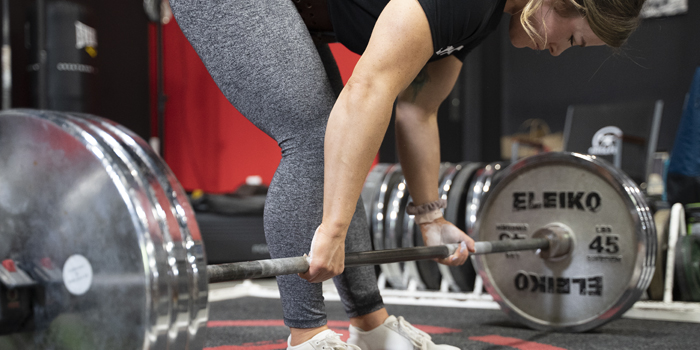
If there's one thing that's highly debatable within the powerlifting community when it comes to max effort conjugate work, it's the use and implementation of backdown sets. Backdown sets are rather popular these days within the undulating periodization crowd, and they have some amazing benefits in improving neurological efficiency within movements.
Suck at using the SSB? Nothing better than decreasing the weight and working on maintaining upper tightness, right?
The main issue with the conjugate crowd is that they want to hit a max effort single, some general accessory work, and call it a day. And if you're a geared lifter, this is often about all you'll either A) have time for or B) feel up to the task of doing once you get your heaviest lift in for the day.
I believe there is some real value in backdown sets and, more importantly, getting the most out of them and figuring out how to gauge your training with the feedback it might give you.
This led me to the APRE method by Dr. Bryan Mann. A huge thanks to my guy, Coach Lucas White, currently at Boise State University, for reminding me and helping me see how he used this system during his path in collegiate strength and conditioning.
Below I'm going to discuss the APRE method in simplistic terms and then describe how I've used it within the conjugate system to have calculated backdowns to acquire improvement and maximize recovery.
APRE Basics
To start things off, if you're the type of strength person who loves to read research, please find the following dissertation that Dr. Bryan Mann put together: A Programming Comparison: The APRE vs. Linear Periodization In Short Term Periods. You can also purchase the book he wrote here at elitefts. Both would be well worth your time.
However, in the simplest terms possible, APRE stands for Autoregulatory Progressive Resistance Exercise. It's autoregulating your training based on the current day's readiness. This process happens nearly every day you train, but Dr. Bryan Mann helps simplify it. Based on your set performance, he provides you with numbers you should be hitting for particular reps. If you fall short or hit more, your subsequent set will adjust. He also has particular rep schemes based on goals, commonly known as APRE3, APRE6, and APRE10. We'll get into these more later.
RECENT: 10 Exercises Powerlifters Should Be Doing (But Aren't) to Stay Pain...
We've all had those days where training sets feel super light and others where 135 feels like 500. You typically pivot at the moment and then go about your day. But have you ever had those days where weights start to feel better and better after you get going, and next thing you know, you have a PR day? Those aren't as common, but they certainly happen from time to time. I enjoy this piece of APRE because with my clients, I now have concrete numbers of how they feel, and they can also learn how to use their RPE and be more in tune with it.
Implementing APRE With Max Effort Conjugate Training
While the conjugate system is amazing and has seen huge growth and popularity thanks to Louie, I'm always looking for my own ways to tweak and adjust things more to my liking and for my clients. That's the beauty of the system - you can make it your own. This led me to wonder how to improve a max effort movement if you only happen to see it every six-12 weeks. Part of training progression is specificity, or the SAID principle (specific adaptation to imposed demands). At first, I would decrease the weight by ~10-15% and do a couple of sets and reps. But I wouldn't make progress, or I'd feel crushed the next day. Here's where I started to use the APRE method and tinker with my bench press.
After looking at the APRE charts that Dr. Bryan Mann has available in his work, I knew that if I wanted to get stronger, I needed to use the APRE3 method, focusing more on strength. After tinkering with numbers and implementation, here is what I came up with depending on the goals for the day:
| 1RM | 3RM | 6RM | 10RM | ||||
| 1st Set Reps | 2nd Set | 1st Set Reps | 2nd Set | 1st Set Reps | 2nd Set | 1st Set Reps | 2nd Set |
| 1-2 | Decrease 5-20 pounds | 1-2 | Decrease 5-20 pounds | 3-5 | Decrease 5-20 pound | 6-9 | Decrease 5-20 pound |
| 3-4 | Same | 3-5 | Same | 6-9 | Same | 10-14 | Same |
| 5+ | Increase 5-20 pounds | 6+ | Increase 5-20 pounds | 10+ | Increase 5-20 pounds | 15+ | Increase 5-20 pounds |
This might look super confusing but bear with me.
At the top of the chart, we have 1RM, 3RM, 6RM, and 10RM. These would be your top sets for the day. Below each rep max, you then have a column for your first backdown set of reps that you completed, a recommended second set, and how you would adjust. What isn't shown is that the first backdown will always be 92.5% of your top weight used for the day. This is designed to take into account fatigue on all levels, and it took me some time to find a good number that would be good for the majority of lifters.
Something that you always need to keep in mind is that the adjusted weights will always have ranges. This is because every lifter is different, and how much you lift will dictate how much you should adjust. For example, a 148-pound female athlete who benches 135 pounds will not need to increase or decrease nearly as much weight for the adjusted sets. However, a 220-pound male with a 650-pound squat will certainly need to strip more weight off the bar if they need to decrease weight. When in doubt, I suggest taking more weight off or adding less total weight.
To see how this looks, here's an example from one of my lifters bench press sessions using the 3RM protocol:
Max Effort Upper
Bench Press vs. Bands and Chains: Use doubled micro mini bands and one chain per side
Work up to a heavy triple (@ RPE 9) with APRE
Set 1: 155x3
Set 2: 140x4
Set 3: 140x3
As we can see, since his first backdown, he only managed to get four reps. Therefore, he needed to keep the weight the same for the last adjusted set. This tells me he did a good job gauging his top triple for the day. If we also look at Prilepin's Chart, these numbers align with what we would want for optimal training.
Here's one where a lifter had a pretty rough training session, and squats didn't go where we needed them to:
Max Effort Lower
SSB Box Squat: Box slightly below parallel
Work up to a heavy single (@ RPE 9.5) with APRE
Set 1: 470x1
Set 2: 435x2
Set 3: 425x2
This particular lifter noted in their comments section that weights felt heavy and had been a rough day at work. Unsurprisingly, we didn't get a PR single, and our backdown sets didn't go so hot, either. Ideally, he would have had a bigger drop on the third set, but knowing that four plates on a SSB is 425, you can likely bet he was ready to get the shit over with. This training day tells me we need to pull back a bit or adjust the next week of training accordingly.
The 6RM and 10RM
This is a great area to look at and implement some of the APRE methods into your supplemental work. I typically like supplemental work to be more in the six-10 range when possible, which is where I'd use them. I've only used them for a 12-week cycle, and after that, I realized this is for the lifters that have great recovery and need to put on size. If you're going to use these within the conjugate system, DO NOT do the APRE work for your max effort work and then this for your supplemental work. You will feel like shit in no time. I tried it with my bench press and my recovery could not keep up.
I suggest picking where you are in your yearly calendar and then deciding what you need more (size or strength). When jumping back into barbell work after a meet, I think the APRE6 and APRE10 are great ways to get solid work in without killing yourself. If you're deep into the off-season and trying to push strength, I would go more of the APRE1 and APRE3 methods with your max effort work.
Final Thoughts
While this implementation may look super confusing at first, I promise if you can do some simple math (92.5% of your top work), you can make the APRE system work well for you within the conjugate system. I always struggled to figure out backdown work and the balance it takes to improve yet not overtrain. This system has worked incredibly well for me and dozens of lifters I've worked with. The beauty is that at the end of the day, you're getting the most optimal work you can for that given day, which is all you can ask for in training.
Thanks again to Dr. Bryan Mann for his research and for providing the information I could use to make educated decisions implementing this material and training rationale.
Brandon Smitley is a 2011 graduate of Purdue University, where he earned his Bachelor’s degree in Health and Fitness, and of Indiana State University with his Master's Degree in Coaching. His best lifts to date are a 567-pound squat, 330-pound bench, 510-pound deadlift, and 1377-pound total in the 132-pound weight class! Brandon holds his CSCS, USAW, and CPT certifications. He has opened THIRST with his wife, Adrian, to help athletes and others realize their full potential from proper strength training methodologies.











This is «seemingly» complicated but actually quite simple! I've taken a break from heavy training and this is a simple autoregulatory way to get back into the big lifts. Will start testing out with myself and my athletes right away!